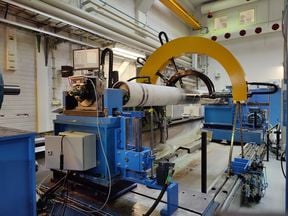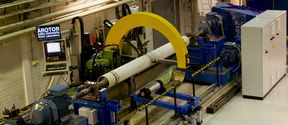Aalto ARotor Lab
The ARotor laboratory is a full scale rotor laboratory with facilities to measure rotors of up to 25,000 kg.

The BETTER project addresses an identified challenge in the paper industry: condition monitoring systems, quality control systems and laboratory measurements are commonplace in paper mills, but the data is not used to its full potential, slowing down growth and reducing profitability in paper production. By utilizing measured machine direction quality variation data and relating this data to individual machine elements with modern signal processing tools, the project aims to improve roll service and troubleshooting of paper machines to increase the overall efficiency and productivity of the paper production process as a whole.
CO-DES generates a paradigm shift in complex system design towards a truly collaborative digital design process. The project researches architecture and platform for open model share and co-simulation. In addition, advanced models of various ship powertrain components, such as variable frequency drives, electric motors, and thrusters, are developed, and methods to protect their IPR are investigated. The advanced IPR-protected models are openly shared, enabling complete powertrain co-simulation already in the early phase of the design process. This co-simulation allows the selection of the most suitable components, optimizing powertrain performance, and minimizing the use of resources.
The application example selected for the project is a ship's powertrain design. However, the collaborative design approach is exploitable in a wide range of other industrial sectors as well. Adopting the collaborative digital design process based on co-simulation with IPR-protected openly-shared models would widely benefit the Finnish industry and help to gain a competitive edge.
CO-DES digitalizes the collaborative powertrain engineering with openly shared models
The Data Analytics for Zero Emission Marine (DAZE) research project aims at significant energy efficiency and marine system performance improvements using a data-driven process. By using data, energy efficiency can be improved, and the availability of systems can be increased by systematic, coordinated, and well-integrated use of data. The DAZE project will produce innovative ways of using a model-driven augmented machine learning (ML) and artificial intelligence (AI) approach to reach the next level of utilization of data produced on-board ships. In the Work Packages defined in the DAZE project algorithms and methodology for fault diagnostics, energy system modelling and optimizations, and virtual data sets generation are developed. This development is done is in parallel by research on data and computing management, with novel research on how edge and cloud operations should be coordinated and co-used in the maritime domain.
POWER Beyond develops novel technological solutions for Finnish export industries to support their strive towards sustainability and circularity:
The world is being electrified at unparalleled pace, from transportation to industrial processes and complete energy systems. As a result,there is an incomparable need for energy, material and cost-efficient electrical machines, drives and powertrains. The Academy of Finland’s Centre of Excellence in Electromechanical Energy Conversion and Transfer brings together the key Finnish academic experts on the electrical machines, drives, mechanical transmission and related system analysis, with the aim to elevate the modelling and analysis capabilities and methodologies eventually leading to the emergence of highly sustainable solutions and products necessary fora cleaner future. Our approach is to capitalise on the high frequency solutions currently not fully explored. The consortium leader and its members are internationally recognised with proven track records and excellent networks providing the perfect framework for the renewal of science and technology.
Artificial intelligence optimization of rotating machinery governed production lines
The AI-ROT project, funded by Academy of Finland, investigates the runnability and quality of production lines governed by rotating machinery, especially products formed by rolls, such as paper, cardboards or steel.
Methods for modelling the end product quality as well as methods for separating the effects of geometry errors of different rolls from measured end product quality variation will be developed in the project. Additionally, the project focuses on how to utilize the information in operation and maintenance of the production line.
Metrology for enhanced reliability and efficiency of wind energy systems
The Met4Wind project is focused on improving dimensional metrology for drivetrain components and rotor blades for wind energy systems. Accurate metrology is a prerequisite to enable reliable production processes for fail-safe parts. Additionally, improved metrology and better rotational accuracy contribute to improving the availability and efficiency of wind energy systems.
The project 19ENG07 Met4Wind has received funding from the EMPIR programme co-financed by the Participating States and from the European Union’s Horizon 2020 research and innovation programme.
Visit the Reboot IoT Factory webpages
Digital Twin of Rotor system
Funded by the Academy of Finland, the TwinRotor project conducted between 2017 and 2019 focused on the digital twin of a rotor system. A proof of concept digital twin system was conceived during the project and a data driven machine learning model for the dynamic behaviour of rotors was created. Further applications of similar data driven methods are virtual sensors utilizing collected data from a fleet of installed products, which can improve condition monitoring and predictive maintenance services.
Communication and validation of smart data in IoT-networks
The central mission of the SmartCom project is to establish a secure, unambiguous and unified exchange of data in all communication networks where metrological data is used. SmartCom will develop, provide and distribute a formal framework for the transmission of metrology data on the basis of the SI (International System of Units). The framework will be applicable to all metrology domains. Furthermore, a worldwide-applicable concept for the use of digital calibration certificates (DCC) will be made available for the first time. The development of demonstrators in two industrial domains will also prove the benefit and innovation potential of the project’s outputs for industry.
Traceable measurement of drivetrain components for renewable energy
Wind energy systems are regarded as one of the most promising technologies for the generation of renewable energy. However, the reliability of the drivetrain components needs to be improved. The high costs associated with the repair of drivetrain components of large scale wind mills and also lost power generation due to unplanned maintenance is a common problem for renewable energy suppliers. The DriveTrain project developed new approaches to deliver measurement standards and procedures to enable the reliable estimation of a quantitative measurement uncertainty for highly accurate drivetrain components (for bearings, shafts and gears) as demanded in international guidelines and will be optimized for industrial use.
The drivetrain of large scale wind-energy systems consists of large rotating parts. In this project ARotor developed a novel large scale bearing element measurement method and device. Its characteristics and measurement uncertainty were determined in cooperation with VTT/Mikes. In addition, ARotor was responsible for determining measurement strategies for large scale drivetrain components with precise round features together with Moventas. In addition VTT/Mikes and ARotor developed an Interferometric step gauge for CMM verification to tackle the uncertainty issues regarding the measurement of large round features.
Link to research paper on Interferometric step gauge for CMM verification
Traceable in-process dimensional measurements
Traceable in-process dimensional measurements by machine tools offer high product quality, lower manufacturing costs, high productivity and prompt and real-life assessment of product quality. Measurement errors of machine tools are from different sources and are influenced by complex environmental factors on the shop floor.
ARotor was responsible for developing a compensative manufacturing methods for large round workpieces. The work resulted in the verification of compensative 3D grinding method, which uses the four-point hybrid roundness measurement data to compensate the systematic errors occurring during the grinding process. A micrometer level accuracy in roundness was reached. In addition, the first Monte Carlo simulation based uncertainty analyses considering the four-point hybrid roundness measurement method were made. A large scale roundness artefact (diameter 500 mm) with a specific distribution of waviness components of the roundness profile was manufactured.
Virtual Design of Rotating Machines - ViDROM
Novel simulation approaches for transient dynamic analysis of non-ideal rotor-bearing system
ARotor investigated the effect of the bearing inner ring roundness profile on the subcritical vibrations of a flexible rotor. A test bench was developed to verify the investigations with industrial large scale rotor system. The roundness profile for the inner ring of the installed bearing was measured. It was modified to achieve five different geometries to investigate five excitation cases. Rotor subcritical vibration was measured for each bearing inner ring geometry in the horizontal and vertical directions. The analysis focused on the 2nd, 3rd, and 4th harmonic vibration components, which occur at 1/2, 1/3, and 1/4 of the critical rotational speed. The results clearly suggest that the roundness profile of the roller race of the bearing inner ring significantly affects rotor subcritical vibration. The increased waviness components of the bearing inner ring roundness profile increased corresponding subcritical vibration amplitude. Minimizing the roundness error decreased subcritical vibration substantially.
The effects of different bearing and rotor non-idealities on the dynamic behavior of the system were studied with a physical modelling based simulations. Modelling approaches varied from simplified but computationally efficient analytical models to detailed multibody or finite element approaches. The non-idealities studied were rotor asymmetry, bearing misalignment, bearing surface waviness, off-sized balls, and bearing friction. The influence of non-idealities on the dynamic responses of the rotor bearing system, bearing temperatures, and contact stresses were studied. Simulated waviness responses were also verified with experiments. The developed models can be used to predict responses, bearing temperature rise, and contact stresses in the bearing more accurately than was before possible.
During the project, ARotor also developed a test bench to investigate the backup bearings of AMB’s (active magnetic bearings)
Link to conference paper on Backup Bearing Testing Device for Active Magnetic Bearing
A summary of the industrial research project carried out by Aalto ARotor laboratory.
Tribology of thruster lip seals.
New multi-purpose test environment for high-level rotor research to ARotor laboratory.
Motor and generator shaft geometry and roundness measurement.
Research and development of measurement and grinding of barring of coated paper machine rolls.
Optimizing center point position of rolls during turning.

The ARotor laboratory is a full scale rotor laboratory with facilities to measure rotors of up to 25,000 kg.